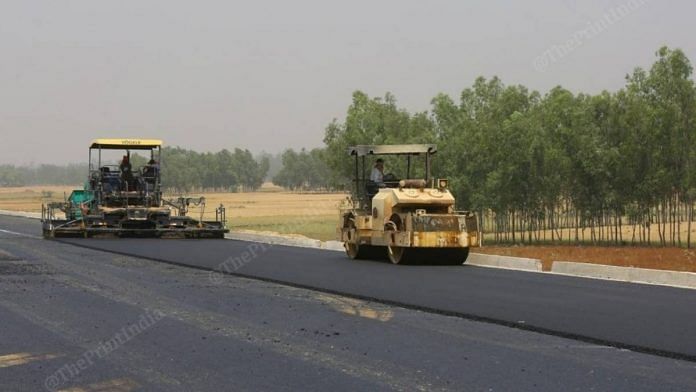New Delhi: The first stretch of green highway being built under the Green National Highways Corridor Project (GNHCP) is expected to be completed by December 2021 in Rajasthan, an official in the Ministry of Road Transport and Highways told ThePrint.
In December last year, the Government of India had signed an agreement for a $500 million project with the World Bank, to develop the GNHCP across 781 km in four states – Rajasthan, Himachal Pradesh, Uttar Pradesh and Andhra Pradesh. The plan is to construct five-six ‘green and safe national highways’ – which have been divided into 23 stretches – as part of the corridor. The entire project is expected to be completed by the end of the 2023-2024 financial year.
The total cost of the project was estimated to be around Rs 7,662 crores, of which the World Bank is contributing Rs 3,500 crore.
The USP of a green highway is in its construction. Compared to a normal highway, a ‘green highway’ uses greener construction technologies, officials explained.
For the GNHCP, a World Bank spokesperson told ThePrint, “The green techniques to be adopted include the maximum use of local materials, stabilisation of soils to reduce the need for crushed stone, use of waste products such as fly ash, recycling asphalt and granular pavements, bio-engineering solutions, water conservation and harvesting techniques, designing for resilience to climate change impacts, and solar lighting.”
The official in the road transport and highways ministry told ThePrint, however, that even the construction of normal national highways have been adopting greener technologies in the past five-10 years.
The GNHCP is being overseen directly by the ministry and the World Bank. “Neither the National Highways Authority of India (NHAI) nor any state PWD is involved in the execution of this project”, explained the above-mentioned official. Usually, the NHAI or the state PWDs are the executing agencies for the construction of highways, he said.
Also read: Despite lockdown, national highway construction hits all-time high of 36.4 km/day in 2020-21
Pros and Cons
While Uttar Pradesh has the highest allocation of 240 km stretch of highway under the project, Rajasthan has the lowest allocation of 116.76 km of the corridor.
Officials from the highways ministry explained that each stretch will be handed over to a different contractor. As yet 10 stretches of land have been awarded to contractors for the project, while tenders have been invited for four more.
“The project will help reduce greenhouse gas emissions by 25 per cent during the construction process, as compared to normal roads, and further reduce emissions in the operation and maintenance of highways (as green highways will use less cement, bitumen and asphalt which are more polluting)”, explained the World Bank spokesperson.
Ministry officials added that “the objective of the project is to demonstrate safe and green national highway corridors in selected states.”
In terms of the long-term impact of the GNHCP, the World Bank spokesperson explained that the hope was to enhance the institutional capacity to build (green) corridors and also to build safe and less environmentally impactful road transport systems.
Vivek Chattopadhyay, a senior program manager at the Delhi-based Centre for Science and Environment, however, explained that the project has certain limitations. According to him, road travel, especially the transportation of goods via roadways, was not efficient
“Transporting goods via roads is neither environmentally friendly nor efficient,” he said, adding that “Thus, just saying green is not enough and this project should not be looked at in isolation”.
Rather, said Chattopadhyay, rail networks needed to be strengthened, so that transportation, especially of goods, could be by trains which are more energy efficient.
(Edited by Poulomi Banerjee)
Also read: NHAI is a gold mine, it will never face debt trap, says Highways Minister Nitin Gadkari



